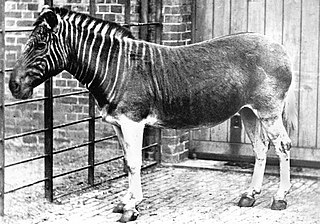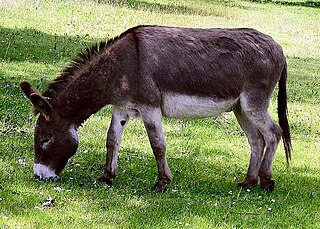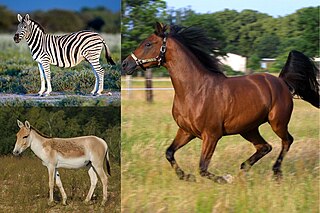
Equidae is the taxonomic family of horses and related animals, including the extant horses, asses, and zebras, and many other species known only from fossils. The family evolved more than 50 million years ago, in the Eocene epoch, from a small, multi-toed ungulate into larger, single-toed animals. All extant species are in the genus Equus, which originated in North America. Equidae belongs to the order Perissodactyla, which includes the extant tapirs and rhinoceros, and several extinct families. It is more specifically grouped within the superfamily Equoidea, the only other family being the extinct Palaeotheriidae.

The quagga is an extinct subspecies of the plains zebra that was endemic to South Africa until it was hunted to extinction in the late 19th century. It was long thought to be a distinct species, but MtDNA studies have supported it being a subspecies of plains zebra. A more recent study suggested that it was the southernmost cline or ecotype of the species.

Zebras are African equines with distinctive black-and-white striped coats. There are three living species: Grévy's zebra, the plains zebra, and the mountain zebra. Zebras share the genus Equus with horses and asses, the three groups being the only living members of the family Equidae. Zebra stripes come in different patterns, unique to each individual. Several theories have been proposed for the function of these patterns, with most evidence supporting them as a deterrent for biting flies. Zebras inhabit eastern and southern Africa and can be found in a variety of habitats such as savannahs, grasslands, woodlands, shrublands, and mountainous areas.

The donkey or ass is a domesticated equine. It derives from the African wild ass, Equus africanus, and may be classified either as a subspecies thereof, Equus africanus asinus, or as a separate species, Equus asinus. It was domesticated in Africa some 5000–7000 years ago, and has been used mainly as a working animal since that time.

The onager (Equus hemionus), also known as hemione or Asiatic wild ass, is a species of the family Equidae native to Asia. A member of the subgenus Asinus, the onager was described and given its binomial name by German zoologist Peter Simon Pallas in 1775. Six subspecies have been recognized, two of which are extinct.

The plains zebra is the most common and geographically widespread species of zebra. Its range is fragmented, but spans much of southern and eastern Africa south of the Sahara. Six or seven subspecies have been recognised, including the quagga which was thought to be a separate species. More recent research supports variations in zebra populations being clines rather than subspecies.

Equus is a genus of mammals in the family Equidae, which includes horses, asses, and zebras. Within the Equidae, Equus is the only recognized extant genus, comprising seven living species. Like Equidae more broadly, Equus has numerous extinct species known only from fossils. The genus originated in North America and dispersed into the Old World and South America during the Early and Middle Pleistocene. Equines are odd-toed ungulates with slender legs, long heads, relatively long necks, manes, and long tails. All species are herbivorous, and mostly grazers, with simpler digestive systems than ruminants but able to subsist on lower-quality vegetation.

The maned rat or (African) crested rat is a nocturnal, long-haired and bushy-tailed East African rodent that superficially resembles a porcupine. The world's only known poisonous rodent, the maned rat sequesters toxins from plants to fend off predators.

The kiang is the largest of the Asinus subgenus. It is native to the Tibetan Plateau in Ladakh India, northern Pakistan, Tajikistan, China and northern Nepal. It inhabits montane grasslands and shrublands. Other common names for this species include Tibetan wild ass, khyang and gorkhar.

The red gazelle is an extinct species or subspecies of gazelle. It was formerly considered a member of the genus Gazella within the subgenus Eudorcas before Eudorcas was promoted to a full genus. It is thought to have lived in the better-watered mountain areas of North Africa rather than in deserts, because of the rich colouring on the coat.

The African wild ass or African wild donkey is a wild member of the horse family, Equidae. This species is thought to be the ancestor of the domestic donkey, which is sometimes placed within the same species. They live in the deserts and other arid areas of the Horn of Africa, in Eritrea, Ethiopia and Somalia. It formerly had a wider range north and west into Sudan, Egypt, and Libya. It is Critically Endangered, with about 570 existing in the wild.

The Somali wild ass is a subspecies of the African wild ass.

Asinus is a subgenus of Equus that encompasses several subspecies of the Equidae commonly known as wild asses, characterized by long ears, a lean, straight-backed build, lack of a true withers, a coarse mane and tail, and a reputation for considerable toughness and endurance.

The Syrian wild ass, less commonly known as a hemippe, an achdari, or a Mesopotamian or Syrian onager, is an extinct subspecies of onager native to the Arabian Peninsula and surrounding areas. It ranged across present-day Iraq, Palestine, Israel, Iran, Jordan, Saudi Arabia, Syria, and Turkey.

The bubal hartebeest, also known as northern hartebeest or bubal antelope or simply bubal is the extinct nominal subspecies of hartebeest. It was formerly found north of the Saharan Desert. Other subspecies live currently in grasslands south of the Sahara, from Senegal in the west to Eritrea and Ethiopia in the east and down to central Tanzania. The red hartebeest and Lichtenstein's hartebeest, alternatively considered subspecies or sister species of the common hartebeest, are present in southern Africa.

The Nubian wild ass is the nominate subspecies of African wild ass, and one of the ancestors of the domestic donkey, which was domesticated about 6,000 years ago. It is presumed to be extinct, though two populations potentially survive on the Caribbean island of Bonaire and in Gebel Elba.

Primitive markings are a group of hair coat markings and qualities seen in several equine species, including horses, donkeys, and asses. In horses, they are associated with primitive breeds, though not limited to such breeds. The markings are particularly associated with the dun coat color family. All dun horses possess at least the dorsal stripe, but the presence of the other primitive markings varies. Other common markings may include horizontal striping on the legs, transverse striping across the shoulders, and lighter guard hairs along the edges of a dark mane and tail.

The Turkmenian kulan, also called Transcaspian wild ass, Turkmenistani onager or simply the kulan, is a subspecies of onager native to Central Asia. It was declared Endangered in 2016.

















